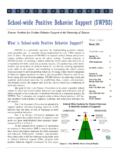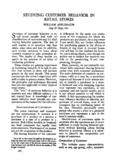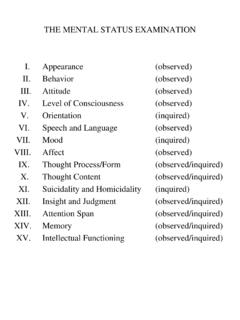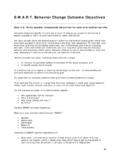Transcription of Theories of Behavior Change
1 Theories of Behavior Change | CommGAP Theories of Behavior Change Defining Theories of Behavior ChangeBehavior Change is often a goal for staff working directly with constituents, organizations, governments, or communities. individuals charged with this task can be thought of as interventionists whose goal it is to design and implement programs or interventions that produce the desired behavioral changes1 (Glanz, Lewis, & rimers, 1990, p. 17). As Glanz, Lewis, and rimmers1 suggest, designing interventions to yield Behavior is best done with an understanding of Behavior Change Theories and an ability to use them in practice (1990, p.)
2 19). the goal of this Gravitas, therefore, is to introduce three major Theories of behav-ior Change , describe the key variables of Behavior Change models, and to explore the link between behav-ior Change and Key elements of Behavior Change Before exploring Behavior Change models in depth, it is important to understand the variables that are essential to the models. Below is a select list of the variables common to many Behavior Change models2 as well ways to maximize on these variables when attempting to evoke a Behavior Change . 1 Glanz, K.
3 , Lewis, F. M., & rimers, B. K. (eds.). (1990). Health Behavior and Health Education: Theory, Research, and Practice. san Francisco, CA: Jossey-Bass. 2 Witte, K. (1997). research review theory-based interventions and evaluations of outreach efforts [electronic version]. Planning and Evaluating Information Outreach among Minority Communities: Model Development Based on Native Americans in the Pacific North-west. retrieved January 29, 2006 from elementDefinitionstrategies for Behavior ChangethreatA danger or a harmful event of which people may or may not be aware.
4 Raise awareness that the threat exists, focusing on severity and arousal caused by perceiving a significant and personally relevant threat. Fear can powerfully influence Behavior and, if it is channeled in the appropri-ate way, can motivate people to seek information, but it can also cause people to deny they are Efficacy Perception that a recommended re-sponse will prevent the threat from happening. Provide evidence of examples that the recommended response will avert the individual s perception of or con-fidence in their ability to perform a recommended individuals confidence that they can perform response and help ensure they can avert the threat.
5 (continued) Theories of Behavior Change | CommGAP | 2 Major Theories of Behavior Change1. social Cognitive theory3,4 Bandura s social Cognitive theory proposes that people are driven not by inner forces, but by exter-nal factors. this model suggests that human func-tioning can be explained by a triadic interaction of Behavior , personal and environmental factors (see figure 1). this is often known as reciprocal deter-minism. environmental factors represent situational influences and environment in which Behavior is preformed while personal factors include instincts, drives, traits, and other individual motivational forces.
6 Several constructs underlie the process of human learning and Behavior these variables may also intervene in the process of Behavior A judgment of one s ability to perform the Expectations A judgment of the likely consequences a Behavior will produce. the importance of these expectations ( , expectancies) may also drive the ability of an individual to control their something that increases or decreases the likelihood a Behavior will elementDefinitionstrategies for Behavior ChangeBarrierssomething that would prevent an individuals from carrying out a recom-mended aware of physical or cultural barri-ers that might exist, attempt to re-move consequences of performing recommended the benefits of perform-ing the recommended normsWhat an individual thinks other people think they should do.
7 Understand with whom individuals are likely to individual s evaluation or beliefs about a recommended existing attitudes before at-tempting to Change individual s plans to carry out the recommended if intentions are genuine or proxies for actual to Actionexternal or internal factors that help individuals make decisions about a communication that might trig-ger individuals to make an individual reacts against a recommended individuals do not feel they have been manipulated or are unable to avert the factorsEnvironmentalfigure 1. social Cognitive theory Model 3 Bandura, A.
8 (1986). Social Foundations of Thought and Action. englewood Cliffs, new Jersey: Prentice-Hall. 4 Perry, C. L., Barnowski, t., & Parcel, G. s. (1990). How individuals, environments, and health Behavior interact: social learning theory. in K. Glanz, F. M. Lewis & B. K. rimer (eds.), Health Behavior and Health Educaiton: Theory Research and Practice. san Fran-cisco, CA: of Behavior Change | CommGAP | 3 Emotional Coping the ability of an individual to cope with emotional Learning the acquisition of behaviors by observing actions and outcomes of others can this theory inform your practice?
9 To increase levels of self-efficacy it may be important to provide resources and support to raise individual confidence. Others have suggested that to raise self-efficacy Behavior Change should be approached as a series of small 3 writes that even when individuals have a strong sense of efficacy they may not perform the Behavior if they have no incentive. this seems to suggest that if we are interested in getting others to enact Behavior Change it may be important to provide incentives and rewards for the the environment may encourage Behavior Change .
10 This may include providing opportunities for behavioral Change , assisting with those changes, and offering social it is important to recognize environmental constraints that might deter Behavior theory of Planned Behavior5,6,7 the theory of planned Behavior (figure 2) suggests that Behavior is dependent on one s intention to perform the Behavior . intention is determined by an individual s attitude (beliefs and values about the outcome of the Behavior ) and subjective norms (beliefs about what other people think the person should do or general social pres-sure).

















